Susan
Forum Replies Created
Viewing 20 posts - 1 through 20 (of 20 total)
-
SusanParticipantMy best takeaway from this class has been the inspiration to just get out the tools we've been using and get going. I usually take a long time to get something started, but look! I've just put pencil and color to some ideas I've been contemplating, and that's a huge step, really. I don't know if I'll be able to share finished pieces with the group, probably not, but now we get to spread our wings and fly off to do our own things...
 I'm looking forward to pulling these ideas together, solving the perspective problems - and having fun with it. in reply to: Tips to Keep You Going #961538
I'm looking forward to pulling these ideas together, solving the perspective problems - and having fun with it. in reply to: Tips to Keep You Going #961538 -
SusanParticipantMay 4, 2023. Favorite nature writers - I had trouble with this one, not sure why, because I read a LOT of natural history, or non-fiction with natural leanings. I came up with authors whose writing I have loved, such as Scott Wiedensaul's Living on the Wind (a deep dive into bird migration), Mia Kankimäki's The Women I think about at Night (travel, exploration, writing, thinking, self-reflection). But I don't consider them "nature writers". Mark and Delia Owen's The Cry of the Kalahari is another. What I love about these three (and many others) is the quality of the writing, the storytelling, and how evocative they are of place - which I think perhaps is what I'm trying to explore in my field sketching. If I can feel a place in a way that allows me to produce a watercolor sketch that evokes that feeling, well, then I've arrived! Reflections - When I wander out in the woods, I certainly reflect on my surroundings, but I don't tend to express that in my journal. When I tried to organize these thoughts, it turns out that they lean toward reflections on the people who have made an impact long before I stood in that spot. Stone Walls - Was there a solitary farmer, making the rounds, picking up stones after winter had passed? was it a family outing to pile the stones, step back, have a look, and add one more? Was it to keep the cows out? keep the cows in? The landscape looked much different then than it does now... I'm here for the trail through the trees - those farmers worked hard to remove the trees - clear the land for a hay field, for a pasture. And once felled, what became of those fallen oaks? lumber, fence posts, firewood? a house, a barn? Now the oaks fall and lie there - scaffolding for a squirrel, upturned roots offering underground crannies for a black rat snake, a chipmunk (ah - one or the other, not both). One day I'll try to capture a stone wall in watercolor - there is so much to it :-) When my thoughts turn to birds or plants - I tend to think about early naturalists - not in Connecticut specifically, but those who wandered the forests and clearings well before the farms were everywhere. They were collectors of observations but also of objects (plants, birds). The Baltimore Oriole caught my attention today - the first I've seen this spring. What a great example. Wikipedia says Carolus Linnaeus described and named it in 1758, based on the heraldic colors of Lord Baltimore (golden yellow and black). Well, a deeper dive shows that English settlers in the area that became the US state of Maryland were calling it the Baltimore Bird in 1669, and yes, they named it for one of their colonial governors, indeed of the Baltimore lineage. Now I find Mark Catesby, a young Englishman and one of the first naturalist/artists of the American colonies, who included this bird in his work The Natural History of Carolina, Florida and the Bahama Islands, published in 1731. Catesby called it Icterus, the Baltimore Bird. Carl Linnaeus very likely used Catesby's description in his Systema Naturae (10th edition), but changed the name to Baltimore Oriole because he (old Carl) was familiar with the European orioles that look similar - but Catesby was right! It's an Icterus, of the American family of blackbirds.
 Mark Catesby's Baltimore Bird (above) and my Baltimore Oriole (below, done a few weeks ago, for a friend).
Mark Catesby's Baltimore Bird (above) and my Baltimore Oriole (below, done a few weeks ago, for a friend).
 I'll wrap up my reflections with this - Naturalists, scientists, observers, thinkers, artists, journallers - we have all been at this task for CENTURIES!! Linnaeus may have put his binomial pen to paper in 1758, but I've only scratched the surface, and found that he stood on the shoulders of oh so many others. We now have incredible access to information, but those facts are built from the observations of people like us, through centuries of spending time in nature, with journal and sketchbook in hand.
It has been so wonderful to spend this time with all of you, these last few weeks, and to see your sketches, paintings, observations, words, poetry. Wow, you are all an inspiration. I'm so excited to see what's around the next bend in the trail. - Sue H.
And Liz - thanks for being the spark, so gentle and encouraging, but, as Bruce Springsteen said, you can't start a fire without a spark. in reply to: The Power of Reflection #961468
I'll wrap up my reflections with this - Naturalists, scientists, observers, thinkers, artists, journallers - we have all been at this task for CENTURIES!! Linnaeus may have put his binomial pen to paper in 1758, but I've only scratched the surface, and found that he stood on the shoulders of oh so many others. We now have incredible access to information, but those facts are built from the observations of people like us, through centuries of spending time in nature, with journal and sketchbook in hand.
It has been so wonderful to spend this time with all of you, these last few weeks, and to see your sketches, paintings, observations, words, poetry. Wow, you are all an inspiration. I'm so excited to see what's around the next bend in the trail. - Sue H.
And Liz - thanks for being the spark, so gentle and encouraging, but, as Bruce Springsteen said, you can't start a fire without a spark. in reply to: The Power of Reflection #961468 -
SusanParticipantMay 3, 2023. These little guys have just returned to Connecticut, but I'm pretty confident a field sketch will be nothing like what I've just done! I'm still more comfortable working at my table, but I feel really good about how I've been able to relax my techniques, and accomplish a fun painting, whether at a sit spot outside or copying from a photo indoors. The relax and keep it fun part is not trivial, and I've really appreciated Liz's constant reminders that it's supposed to be fun and to not be too hard on ourselves! In this page I tried to come back to the idea of informational boxes, since at the beginning I said I liked how that looked, how it made the page look more organized. I have to work more on finding the highlights - which parts to leave white. I found this a little difficult in the warbler and I think I laid the color on too bright, when I should have built it up layer by layer. I like the glazing technique for making shadows and I've appreciated the lesson on finding the negative spaces. When drawing the leaves below I started three times before I got the positions and spaces right!
 The pencil sketch was dated April 5th - it has been a very fun month of sketching!
The pencil sketch was dated April 5th - it has been a very fun month of sketching!
 in reply to: See How Far You’ve Come #961297
in reply to: See How Far You’ve Come #961297 -
SusanParticipantMay 2, 2023, Connecticut. I have been very happy with this Koi watercolor set, and find it quite handy to use in the field. I've noticed in the videos that Liz used the pallet in different positions, so I tried that in my field sketching today. If my sit spot is close to the car I bring a folding chair, otherwise I choose a spot with a large rock or something to sit on. Other than the paints and water brush, I bring a pencil, eraser and my binoculars (and a rain jacket!). I love how simple this kit is. Somebody below suggested the cuff of a cotton sock worn around the wrist for blotting the brush, instead of paper towel (which inevitably blows away!). This sounds like a winner - I'll try it!
 I'm usually overwhelmed when I sit down to a landscape, and found Liz' suggestion to define the planes and layers you see and to gradually block in the areas of color were really helpful. And for some unknown reason today, I was also able to control the waterbrush better, and get some fine lines. Win, win, win! I loved the dramatic sky, but it changed so quickly. I'm glad I took a photo when I first sat down, because the light was so different by the end. This sketch was start to finish 45 minutes - enough time to capture the mood of the moving river and the heavy clouds before the rain returned!
I'm usually overwhelmed when I sit down to a landscape, and found Liz' suggestion to define the planes and layers you see and to gradually block in the areas of color were really helpful. And for some unknown reason today, I was also able to control the waterbrush better, and get some fine lines. Win, win, win! I loved the dramatic sky, but it changed so quickly. I'm glad I took a photo when I first sat down, because the light was so different by the end. This sketch was start to finish 45 minutes - enough time to capture the mood of the moving river and the heavy clouds before the rain returned!
 in reply to: Filling Your Sketches with Color #961180
in reply to: Filling Your Sketches with Color #961180 -
SusanParticipantI'm loving that strutting grackle too - you can really see her personality. Nicely captured!!in reply to: Filling Your Sketches with Color #960941
-
SusanParticipantScott, this is exactly what I've come away with in this class - I usually take forever, but now I'm able to complete something in a reasonable amount of time! For me it's a combination of the techniques and Liz's constant refrain to not be hard on yourself!in reply to: Filling Your Sketches with Color #960939
-
SusanParticipantLeslie, this painting makes me smile. I see a place you love, I see home. Beautiful.in reply to: Filling Your Sketches with Color #960930
-
SusanParticipantI think I tend to try to draw with watercolors, rather than paint - if that makes sense. The wet on dry technique works great for that. Wet on wet was fun, but I have to learn to let the paint go, and not try to control it so much. The dry on dry seemed good for suggesting texture in an area.
 Below I attempted to capture the colors of an early spring day in Connecticut. The wet on wet worked well for suggesting the light foliage and sky, and wet on dry defined most of the shapes in my landscape. I wasn't able to achieve dry on dry with the water brush.
Below I attempted to capture the colors of an early spring day in Connecticut. The wet on wet worked well for suggesting the light foliage and sky, and wet on dry defined most of the shapes in my landscape. I wasn't able to achieve dry on dry with the water brush.
 in reply to: Getting Comfortable with Watercolor #959742
in reply to: Getting Comfortable with Watercolor #959742 -
SusanParticipantApril 20, 2023. Here's my field sketch using the extended arm measuring tool. My learning note wasn't about proportion so much as about finding a way to simplify a landscape - I'm accustomed to putting in detail, and there was just too much going on here. I tried squinting, to pull out the lights and darks, but ultimately decided the light was pretty uniform. Onward!
 in reply to: Getting the Proportions Right #959739
in reply to: Getting the Proportions Right #959739 -
SusanParticipantRevising a gesture sketch is something I've never done before. That aside, I find I was really looking for the negative spaces. This gallinule cries for color, however - can't wait!

 in reply to: Giving Your Drawings Depth #959590
in reply to: Giving Your Drawings Depth #959590 -
SusanParticipantApril 19, 2023. A backhanded compliment coming up: Dear Liz - that was painful - but I have to hand it to you - now I feel like I can do absolutely anything. That exercise perfectly combined everything you demonstrated in this lesson and the previous one as well. Although I know the song sparrow, I found that because it was upside down and looking over its shoulder, all familiar landmarks were gone and I had to follow negative shapes, proportions, relative positions, contours. Wow.
 in reply to: Drawing What You See – Upside Down Drawing #959573
in reply to: Drawing What You See – Upside Down Drawing #959573 -
SusanParticipantApril 18, 2023 - was chilly out today, so I wimped-out and sketched indoors. My still life was fun to arrange, with the objects adjacent to each other and then quite separated. I usually try to capture these positional relationships by eye, but the brain plays tricks and I found the measuring exercise very helpful. And the negative space awareness also helped get things positioned on the page. I think it will be a challenge to practice this in the field - but I'll give a landscape a try.

 in reply to: Getting the Proportions Right #959484
in reply to: Getting the Proportions Right #959484 -
SusanParticipantI'll definitely have to play around a bit to get to know the various colors - I was a little surprised that some of them had opaque characteristics. And the water brush will have a learning curve too - never tried one of those, but I can see how it would be useful for little field studies! Creating the color palette was fun. Relationships - three of my swatches shared a color - I noted the corresponding number from the pans beside each swatch.
 in reply to: Capturing Nature’s Color Palettes #958932
in reply to: Capturing Nature’s Color Palettes #958932 -
SusanParticipantApril 13, 2023. Connecticut. This exercise made me work to catch basic shapes more quickly, such as how the cormorant's body was rather angular. I was using my binoculars constantly, since my subjects were rather distant... maybe next time I'll bring along a spotting scope - but I really want to keep my field sketching portable - minimize the equipment!

 in reply to: Capturing Behavior – Gesture Drawing #958544
in reply to: Capturing Behavior – Gesture Drawing #958544 -
SusanParticipantThere's an art to this, for sure. Slowing down helped!


 in reply to: Focusing on Your Subject – Blind Contour Drawing #958487
in reply to: Focusing on Your Subject – Blind Contour Drawing #958487 -
SusanParticipantApril 12th, 2023, Connecticut. I noticed a little Sanguinaria blooming, and had to sketch it - and then I compared it to another, growing in different corner of the yard. Your prompt questions are super-pertinent to my effort - Balance is the key word. My writing took over the page. Next time I'll try those boxes! and write neatly, and perhaps make my observations more precise. Part of the problem may have stemmed from the fact that when I started the left half of the page, I hadn't chosen a subject for the right half yet (oops) and didn't really have a plan...
 in reply to: The Power of Comparison #958479
in reply to: The Power of Comparison #958479 -
SusanParticipantApril 10, 2023, northeastern Connecticut. Observations: While I was out on my first "sit spot" excursion, I found two bird species that shared an unusual behavior, and a third species that did something similar, but not exactly the same. I only saw about six species of birds, and for three of them to catch my eye in this way was, well, eye-catching. The Louisiana Waterthrush and the Palm Warbler have just returned from winter in the neotropics, and the Eastern Phoebe has been back for a couple of weeks already. The Waterthrush and this particular warbler are both tail-bobbers and the phoebe is a tail-wagger. The phoebe sits very upright (flicking its tail) and hunts for flying insects from perches in trees. The other two species hold their bodies in a rather horizontal posture and bob their entire back end up and down - they forage either on the ground or from low branches, where they are hunting for various invertebrates. Possible explanations: Does it have to do with the hunting behavior? does it scare up insects? does it give the bird a different perspective by changing the angle at which it views the ground for potential prey? And while we're at it - it's a whole different mechanical action! the phoebe must be using just a few muscles that activate the tail and the waterthrush and warbler use the hip and leg joints, which I suppose would require a little more energy. Further questions: I'm hoping some ornithology graduate student somewhere has taken slow-motion video and analyzed the body motion and the gaze of the bird and the activity of insects around the bird - and already answered my question. But what's weird, is that I saw them all in one outing, and this behavior is not widespread among little songbirds. So, further questions, which other birds do this? and what does the research show?in reply to: Noticing Themes in Nature #958271
-
SusanParticipantVery cool! I feel like I usually take my time when I walk in the woods, even do some birdwatching, but this was completely different. I closed my eyes and listened, felt the breeze, heard the leaves rustle, heard the birds, near and far. The act of taking notes, however, is what really put me in the moment. Spring has just arrived in New England, and I cannot wait to get out there and find another sit spot - or revisit the same one!
 in reply to: Opening Your Senses #958257
in reply to: Opening Your Senses #958257 -
SusanParticipant
 Was fun looking for the various parts of the chiaroscuro. I was curious that my mango had another band of shadow below the reflected light - I think it might have been reflected off the darkest cast shadow? I was glad for the freedom to experiment with the different types of marks - sometimes the hatching was enough, but I found myself cross-hatching and scribbling too. I appreciate others' comments on the difficulty of finding the chiaroscuro in a highly textured object! in reply to: Illustrating the 3D World #958094
Was fun looking for the various parts of the chiaroscuro. I was curious that my mango had another band of shadow below the reflected light - I think it might have been reflected off the darkest cast shadow? I was glad for the freedom to experiment with the different types of marks - sometimes the hatching was enough, but I found myself cross-hatching and scribbling too. I appreciate others' comments on the difficulty of finding the chiaroscuro in a highly textured object! in reply to: Illustrating the 3D World #958094 -
SusanParticipantI often draw birds from photos, so that came easily. The challenge was to keep going once the bird was complete! Once I finish sketching a bird, I usually consider myself done - but having just outlined a bit of a goal about completeness on a page, I went ahead and sketched the branch with a few leaves and even the lichen - and better yet, made some descriptive notes about color and texture. I'm excited to see how my yellow warbler might be different at the end of my journal!
 in reply to: Jump Right in! #957679
in reply to: Jump Right in! #957679
Viewing 20 posts - 1 through 20 (of 20 total)
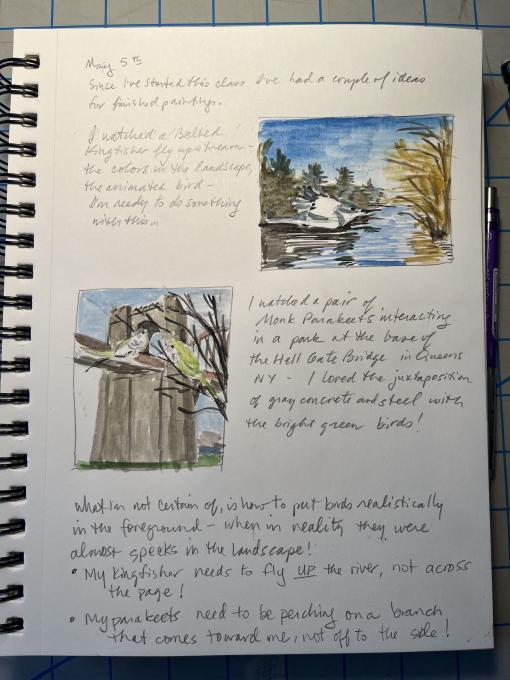 I'm looking forward to pulling these ideas together, solving the perspective problems - and having fun with it.
I'm looking forward to pulling these ideas together, solving the perspective problems - and having fun with it.  Mark Catesby's Baltimore Bird (above) and my Baltimore Oriole (below, done a few weeks ago, for a friend).
Mark Catesby's Baltimore Bird (above) and my Baltimore Oriole (below, done a few weeks ago, for a friend).
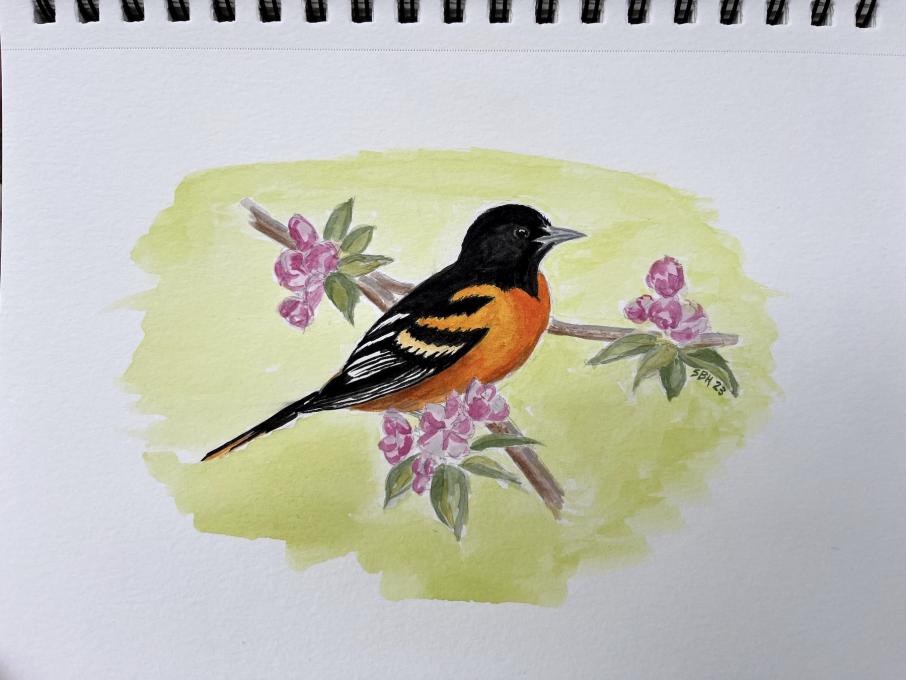 I'll wrap up my reflections with this - Naturalists, scientists, observers, thinkers, artists, journallers - we have all been at this task for CENTURIES!! Linnaeus may have put his binomial pen to paper in 1758, but I've only scratched the surface, and found that he stood on the shoulders of oh so many others. We now have incredible access to information, but those facts are built from the observations of people like us, through centuries of spending time in nature, with journal and sketchbook in hand.
It has been so wonderful to spend this time with all of you, these last few weeks, and to see your sketches, paintings, observations, words, poetry. Wow, you are all an inspiration. I'm so excited to see what's around the next bend in the trail. - Sue H.
And Liz - thanks for being the spark, so gentle and encouraging, but, as Bruce Springsteen said, you can't start a fire without a spark.
I'll wrap up my reflections with this - Naturalists, scientists, observers, thinkers, artists, journallers - we have all been at this task for CENTURIES!! Linnaeus may have put his binomial pen to paper in 1758, but I've only scratched the surface, and found that he stood on the shoulders of oh so many others. We now have incredible access to information, but those facts are built from the observations of people like us, through centuries of spending time in nature, with journal and sketchbook in hand.
It has been so wonderful to spend this time with all of you, these last few weeks, and to see your sketches, paintings, observations, words, poetry. Wow, you are all an inspiration. I'm so excited to see what's around the next bend in the trail. - Sue H.
And Liz - thanks for being the spark, so gentle and encouraging, but, as Bruce Springsteen said, you can't start a fire without a spark. 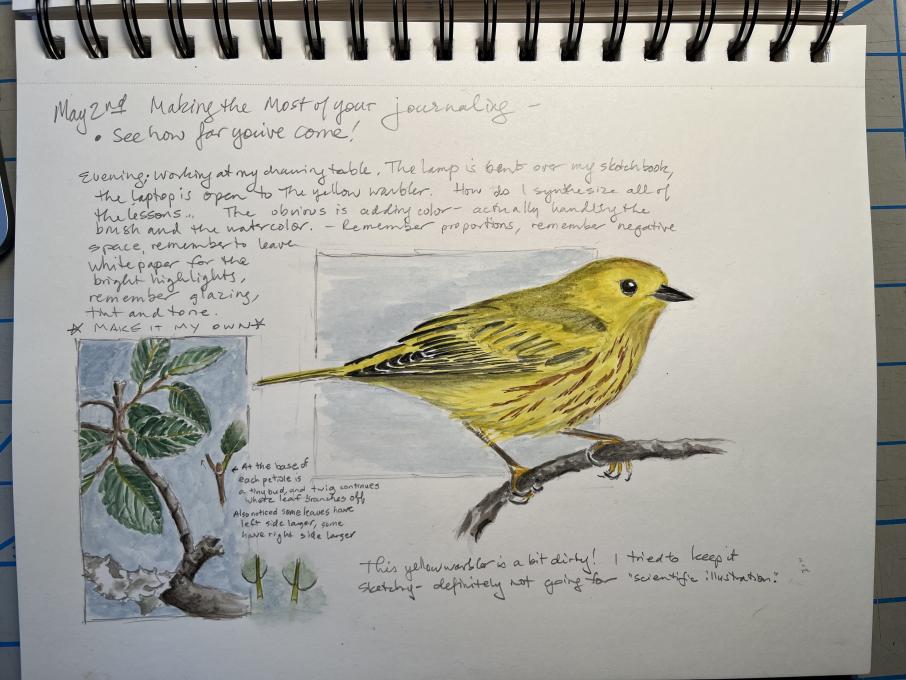 The pencil sketch was dated April 5th - it has been a very fun month of sketching!
The pencil sketch was dated April 5th - it has been a very fun month of sketching!

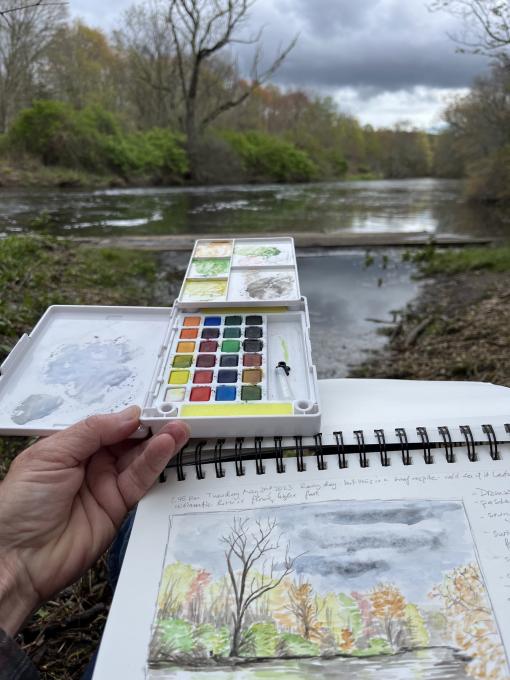 I'm usually overwhelmed when I sit down to a landscape, and found Liz' suggestion to define the planes and layers you see and to gradually block in the areas of color were really helpful. And for some unknown reason today, I was also able to control the waterbrush better, and get some fine lines. Win, win, win! I loved the dramatic sky, but it changed so quickly. I'm glad I took a photo when I first sat down, because the light was so different by the end. This sketch was start to finish 45 minutes - enough time to capture the mood of the moving river and the heavy clouds before the rain returned!
I'm usually overwhelmed when I sit down to a landscape, and found Liz' suggestion to define the planes and layers you see and to gradually block in the areas of color were really helpful. And for some unknown reason today, I was also able to control the waterbrush better, and get some fine lines. Win, win, win! I loved the dramatic sky, but it changed so quickly. I'm glad I took a photo when I first sat down, because the light was so different by the end. This sketch was start to finish 45 minutes - enough time to capture the mood of the moving river and the heavy clouds before the rain returned!

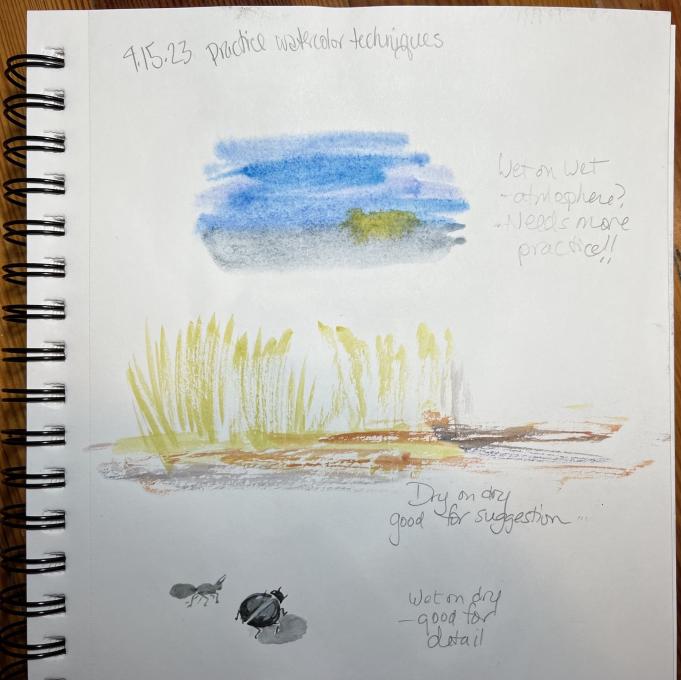 Below I attempted to capture the colors of an early spring day in Connecticut. The wet on wet worked well for suggesting the light foliage and sky, and wet on dry defined most of the shapes in my landscape. I wasn't able to achieve dry on dry with the water brush.
Below I attempted to capture the colors of an early spring day in Connecticut. The wet on wet worked well for suggesting the light foliage and sky, and wet on dry defined most of the shapes in my landscape. I wasn't able to achieve dry on dry with the water brush.





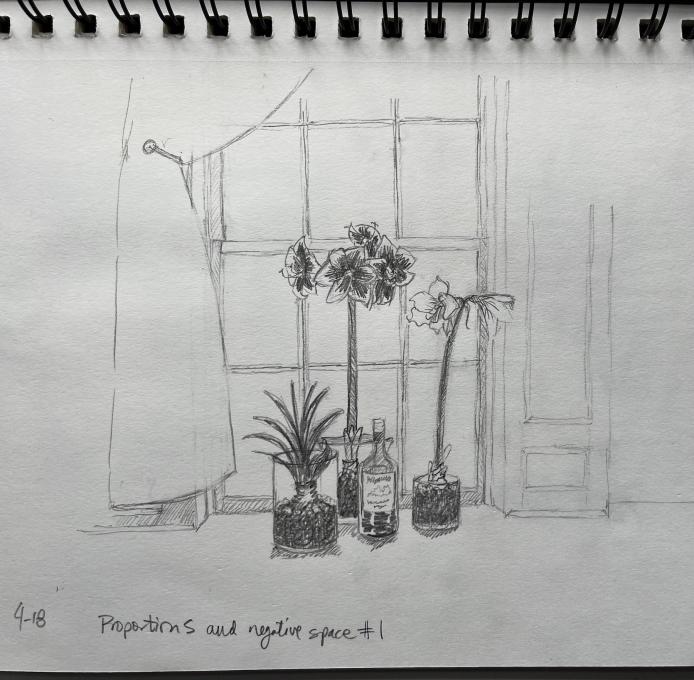
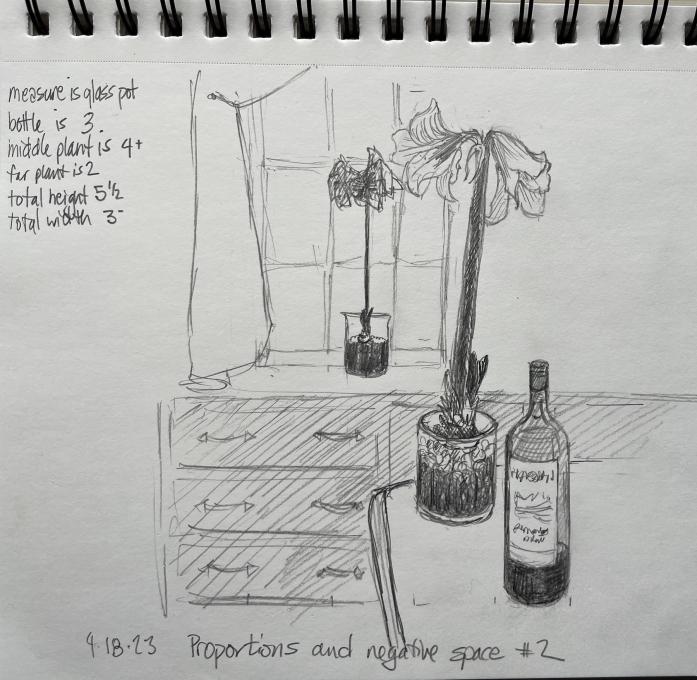

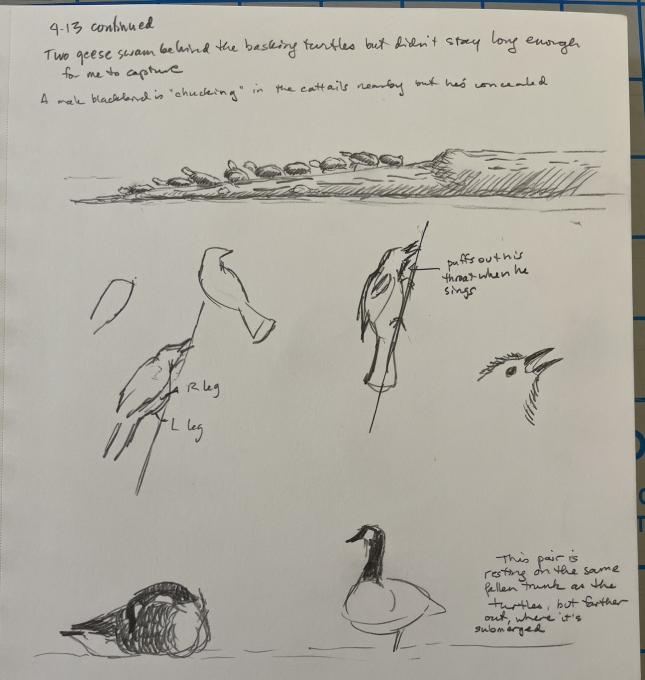




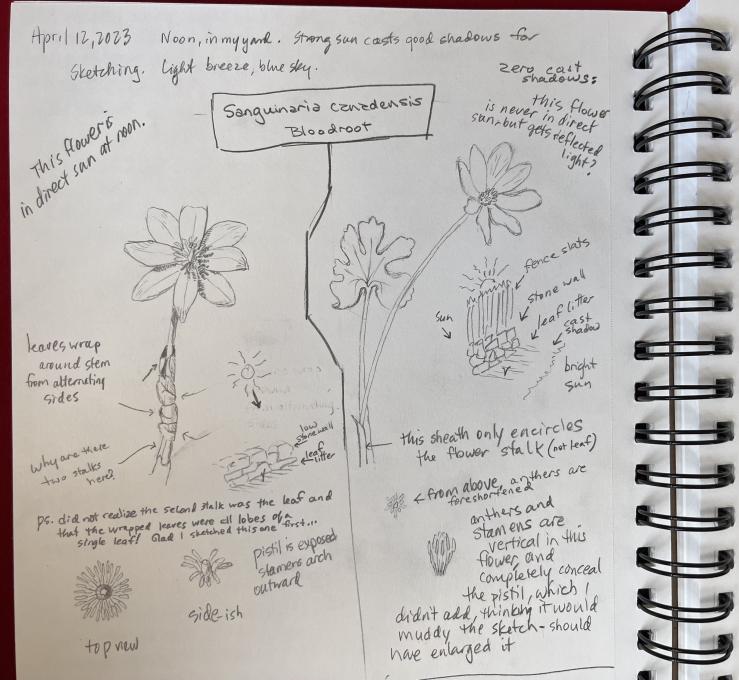

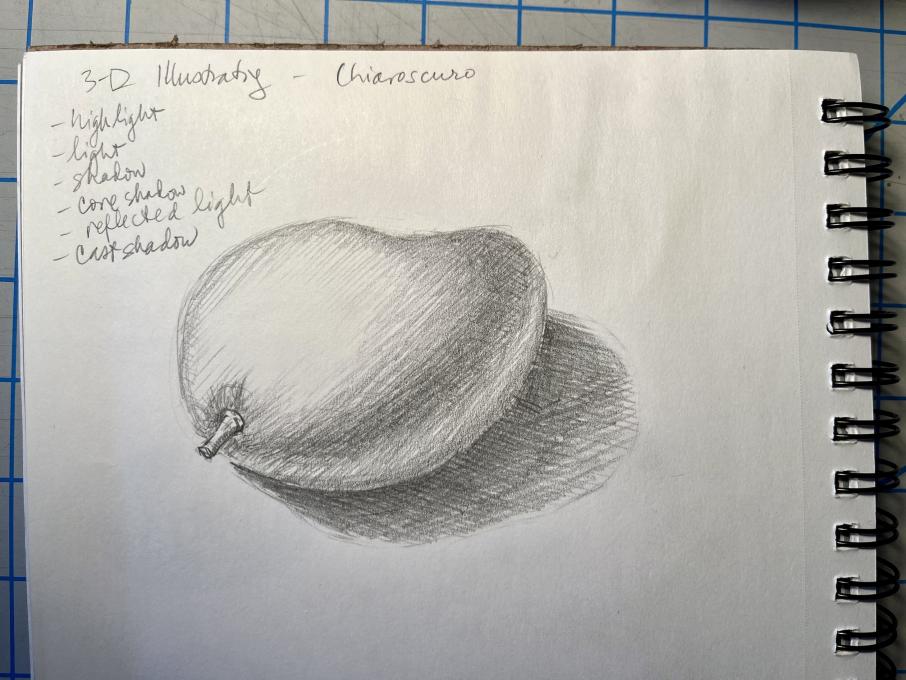 Was fun looking for the various parts of the chiaroscuro. I was curious that my mango had another band of shadow below the reflected light - I think it might have been reflected off the darkest cast shadow? I was glad for the freedom to experiment with the different types of marks - sometimes the hatching was enough, but I found myself cross-hatching and scribbling too. I appreciate others' comments on the difficulty of finding the chiaroscuro in a highly textured object!
Was fun looking for the various parts of the chiaroscuro. I was curious that my mango had another band of shadow below the reflected light - I think it might have been reflected off the darkest cast shadow? I was glad for the freedom to experiment with the different types of marks - sometimes the hatching was enough, but I found myself cross-hatching and scribbling too. I appreciate others' comments on the difficulty of finding the chiaroscuro in a highly textured object! 